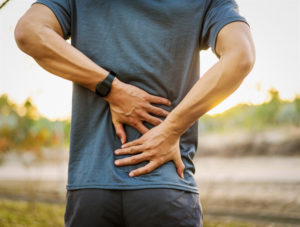
Angela Payumo, MD
INTERNIST
Dr Payumo’s medical practical has taken her around the globe, from the Philippines to Haiti, to various cities in the US. She hails from a family of physicians and has been practicing herself since 2011. Dr. Payumo appreciates the sense of family and community that she sees and feels in Hawaii, and with CloudWell Health she hopes to provide greater healthcare access to the Hawaiian people, and to anyone in immediate need.
Lower Back Pain
About 80% of people experience one or more stints of lower back pain. Very often the exact cause of the pain is unclear and there is no underlying problem. This is referred to as nonspecific lower back pain. There are a variety of methods on how to avoid lower back pain.

What are the types of lower back pain?
1. Nonspecific low back pain
This is the most common type of back pain and the onset is often sudden, sometimes acute. Because there is no specific problem or disease that can be identified and treated as the cause of the pain, this type of pain is usually referred to as nonspecific low back pain. The spectrum of pain can vary from very mild to very severe.
2. Sciatica
When a nerve coming out from the spinal cord is irritated, inflamed or pressed upon you may experience nerve root pain or Sciatica. This can also happen if any of the above happens to the root of the nerve as well. Sometimes it is also called a trapped nerve. Furthermore, it occurs in less than 1 out of every 20 people who complain of acute low back pain. In sciatica, you may experience the following symptoms. For instance:
- Pain along the length of the nerve.
- Pain extending down a leg, sometimes as far as the calf or foot.
- You may experience pins and needles, weakness or numbness in part of a buttock, leg or foot.
90% of nerve root pain cases are due to prolapsed disc, commonly called a slipped disc. While the terminology is misleading, a disc does not actually slip. In reality, a part of the inner gel-like part of the disc bulges outwards. It does this through a weak spot in the outer part of the disc. The prolapsed part of the disc can potentially put pressure on a nerve nearby and that is what sets off the condition.
3. Cauda equina syndrome
Cauda equina syndrome is a very rare disorder. It is where the nerves at the very bottom of the spinal cord are pressed upon. This disorder can cause the following. For instance:
- lower back pain
- problems relating to bowel
- problems relating to bladder function such as being unable to urinate
- numbness in the saddle area (the groin, buttocks, and upper thighs) around the anus
- weakness in either or both legs
This syndrome must be treated as an emergency and requires urgent medical treatment. This is so that the bladder and bowel do not become permanently damaged as a result.
Other causes of lower back pain
- Arthritis. The condition where the joints of the spine become inflamed and painful. Elderly people usually suffer from Osteoarthritis.
- Ankylosing spondylitis. Young adults in sedentary jobs where they have to sit or stand for extended periods of time may experience this. Symptoms include pain and stiffness in the lower back.
- Rheumatoid arthritis. Another cause for lower back pain is the swelling of joints in the spine or elsewhere, which is Rheumatoid arthritis.
- Some rare bone diseases, tumors, infection and pressure from structures close to the spine may also trigger lower back pain as well.
General advise for nonspecific back pain and how to avoid lower back pain:
The pain is usually confined to one area of the lower back but in some cases, it could spread down to one or both buttocks. Or sometimes even the thighs as well. Some tips on how to avoid lower back pain and reasons for lower back pain include:
- Lying down flat may provide some pain relief.
- It is often worsened if you move your back too much, cough, or sneeze.
- Posture and activity may affect the severity of the condition.
Most people with a spell of nonspecific low back pain improve rather quickly, usually within a week or so. Although, sometimes it could take a bit longer.
Once the pain has eased significantly or gone away completely, it is not uncommon to experience recurrences of pain now and then. In a very small number of cases, the pain may persist for several months.
How is it diagnosed?
A physician will usually want to ask questions about your symptoms including how long they have been present, what measure you have taken to relieve pain and will physically examine you. A doctor can usually rule out any other underlying problem and be confident that you have nonspecific back pain.
Some red flags of other serious issues could be:
- Gradually and steadily progressing pain that gets worse over days or weeks.
- Persistent back pain that does not improve by resting/ lying down.
- Pain traveling upwards towards the chest, or higher up in the back behind the chest/ribcage.
- A weakness of any muscles lower limbs or extremities.
- Numbness in any part of your buttock or leg.
- If a long course of steroids have not helped you recover
Symptoms that may indicate ankylosing spondylitis:
- Pain that is worse after waking up or in the second half of the night.
- Stiffness of the back muscles in the morning after getting up from bed that lasts for longer than a few minutes.
- The pain is eased or relieved by activity.
Symptoms indicative of cauda equina syndrome:
- Numbness around the anus and the saddle area.
- Bladder related issues.
- Incontinence of stools.
- Symptoms indicative of a fracture in the spine:
- Physical trauma-induced back pain.
- Experiencing back pain following minor trauma in people suffering from osteoporosis.
Symptoms indicating onset and spread of cancer affecting the spine:
- The onset of pain in an elderly person or someone aged over 60 years, or under 20 years.
- Pain that does not ease when lying down; terrible night-time pains that disturb sleep patterns.
- Symptoms or issues in addition to severe pain such as:
- If you are already suffering from cancer.
- Sudden weight loss, high fever, etc.
- If you take intravenous drugs.
- If you have a poor immune system from previous treatments like chemotherapy or suffer from HIV/AIDS.
What tests will I need to get done?
Your doctor will usually be able to diagnose nonspecific low back pain from the description of the pain you provide him and by physically examining you. Tests such as X-rays, scans or blood tests may be advised in certain situations especially if there are other conditions present.
Treatment for lower back pain and how to avoid lower back pain
Be active
- Try to continue with normal activities as far as possible.
- Don’t do anything that causes or increases existing pain.
Sleep
- Remember to sleep in the most comfortable position on whatever surface is the most comfortable- it does not matter if it is hard or soft.
- Some people reported that a small firm pillow tucked between the knees when sleeping on the side helps relieve pain.
Returning to work
- Aim to get back to work as soon as you can manage.
- There is no real need to wait for the pain to completely go away before returning to work as that could take several weeks.
Exercises
- Some exercises designed by Physiotherapists to work on at home may aid a speedy recovery.
- They may help strengthen lower back muscles in the long run.
- They could reduce the chances or recurrence or severity of the pain when it does come again.
- Taking complete bed rest is not the best way to go about managing back pain.
Medication
- Painkillers like ibuprofen, diclofenac or naproxen can manage the pain. If anti-inflammatories do not work well, codeine may be an option. Constipation is a common side-effect of codeine. This may aggravate back pain if you need to strain to go to the toilet. To circumvent this problem, be sure to have lots of fluids and drink water and eat foods that are rich in fiber.
- A muscle relaxant such as diazepam is rarely prescribed for a few days if the back muscles become very tense and make the pain unbearable. Diazepam can be habit-forming as it provides quick and significant relief from pain and therefore should be taken for a very short period.
If you decide to take painkillers, it is best to take them regularly. This is better than taking them only when the pain is very bad. Taking them regularly ensures that the pain is more likely to be relieved for longer periods of time. This allows you to exercise better and be more active.
What is the prognosis?
- Many nonspecific back pains go away quickly, usually within a week or so.
- In about 7 out of 10 cases, the pain goes away completely or significantly reduces within four weeks.
- In about 9 out of 10 cases, nonspecific back pain goes away in 6 weeks or has reduced in severity by then.
- Even if the pain has eased or gone away, it may come back from time to time in the future.
Chronic low back pain
If nonspecific low back pain lasts for longer than six weeks, it is called chronic back pain. It may last for months, or even years. Symptoms may or may not follow a pattern. You may experience moderate pain levels for a long period of time and smaller bouts of more severe pain.
What is the treatment for chronic nonspecific low back pain?
- Be as active as you can and continue doing your everyday activities to avoid lower back pain.
- Painkillers can help relieve pain.
- Your doctor may resort to a course of amitriptyline- an antidepressant medicine in the tricyclic group. Tricyclic antidepressants can be prescribed to treat conditions other than depression. They may be rarely used to treat back pain.
- An exercise regime designed by a physiotherapist. Often, this happens in a group setting and may go up to 8 sessions. Exercises may be a mix of stretching, aerobic activity, muscle strengthening, movement instruction, and posture control.
- A course of acupuncture may be tried as an alternative treatment but it is unclear how effectively it provides pain relief.
How to avoid lower back pain & prevention of back pain
Research suggests that the best way on how to avoid lower back pain is simply to keep as active as possible and to exercise regularly. General fitness exercises such as walking, swimming, jogging, and running might help in keeping the lower back active and healthy.
Have a pet that needs medical assistance? Telemedicine isn’t only for humans. TelaPets offers medical teleadvice/teletriage with a Hawaii veterinarian, at a time that’s convenient for you. Visit TelaPets to set up a fast and safe virtual visit.
Meet some of our doctors and experts
Here are some of the conditions we treat:
Questions regarding treatment? Contact us! We're here to help.
ALL MAJOR INSURANCE ACCEPTED
Visit with a board-certified Hawaii doctor online or by phone.

Here’s what people are saying
Kaimani
North Shore, Oahu
![]()
"I thought the whole process was pretty cool. To be able do this all on the phone instead of wasting an hour or two to see my doctor and wait all that time to speak with my doctor for only 5 minutes. The best part was I didn't feel rushed either during the video consult. The doctor really took her time speaking with me and more so than my regular doctor would have the time to do so with me.
Susan
Manoa, Oahu
![]()
This was so convenient for me and my family, especially since we are traveling and this saved me a trip to Urgent Care, who knows how long that could have taken. I appreciate how prompt the doctor and the staff were with contacting me.
Meliana
Lahaina, Maui
![]()
This was so great for my Dad to use as he is visiting from another country and he doesnt have health insurance. For something as simple as an earache, we didn't have to spend so much money on a quick doctor's visit. Plus the doctor was able to help my Dad sooner than our scheduled appointment!
Nalu
Mililani, Oahu
![]()
"Everything was very helpful from the initial call down the getting my prescription. I wish I could take this service back home with me to Canada!"
Allie
Lahaina, Maui
![]()
The whole experience was super fast! That was thee fastest appointment I have ever had, especially for something as simple as a prescription refill. Plus I had to pick my son up for school.
Nicki
Kapolei, Oahu
![]()
The fact that I was able to do all of this without getting out of my bed. From the time I made my appointment to hearing my prescription is ready, its been less than 1 hour.
Kawika
Aiea, Oahu
![]()
Video consult was my favorite part. I've never done a telemedicine visit before and it was cool. I can really see this being great for people with busy schedules, not to mention there is nothing like this in Hawaii yet.
Salesi
Lihue, Kauai
![]()
"Convenience from the comfort of your own home. Some times it can be a hassle getting out of house when you're already not feeling well to see your doctor, or even just to get a refill. But this is a very convenient service."
Andrea
Kailua, Oahu
![]()
"Just being able to do it at home and ON TIME was great, because I didn't have to spend the time to commute and spend time in the waiting room to MAYBE see my doctor at my scheduled appointment time. The doctor called me as soon on the dot of my appointment time."
Puka
Waimea, Big Island
![]()
The best part was definitely seeing the doctor on the video call. It is comforting as a patient that there is a real doctor on the other end laying eyes on me and the symptoms I could be having.
Chris
Kona, Big Island
![]()
"The doctor was great and took his time explaining my symptoms and treatment! Actually the whole experience was fantastic! I can't believe how efficient you guys are. It hasn't even been 30 minutes and I've already been contacted by pharmacy that my prescription is ready. This was great. I would definitely use this service again and highly recommend to others!"
We're trusted by local individuals and organizations.









